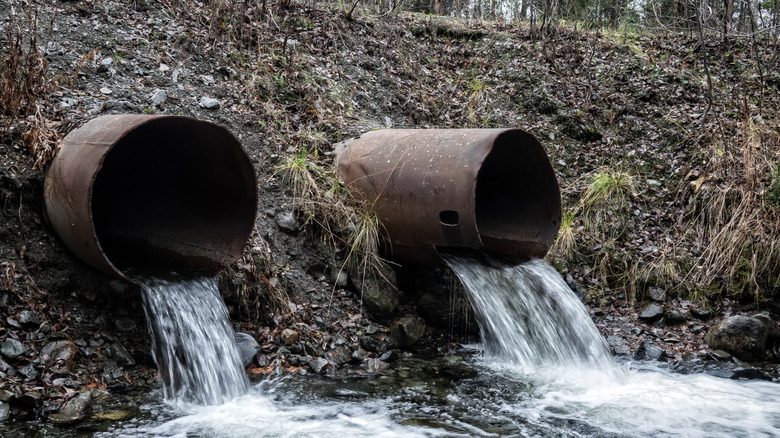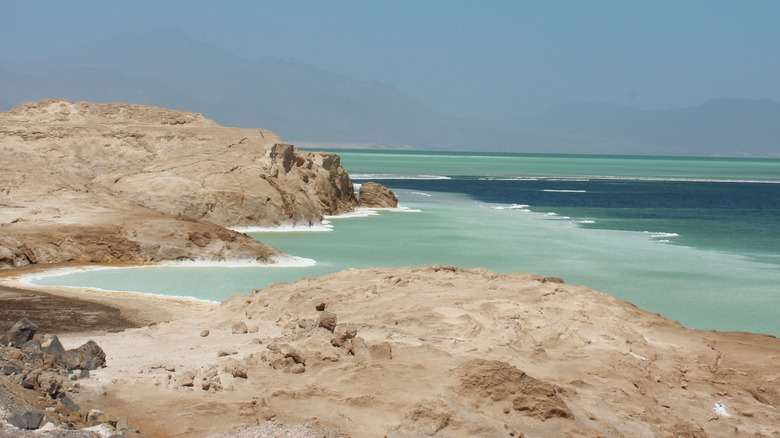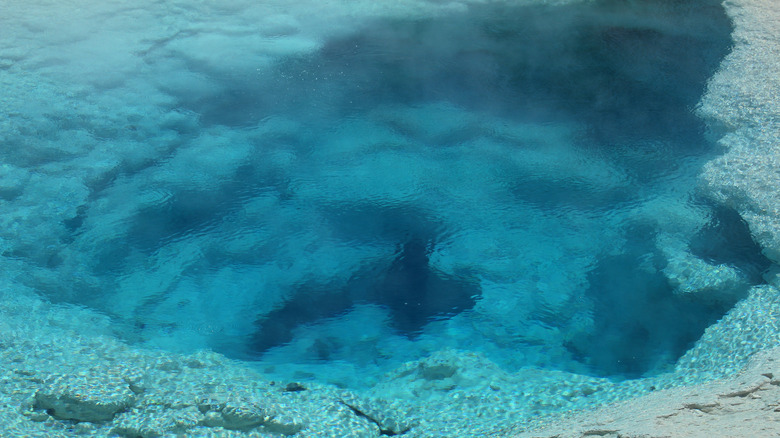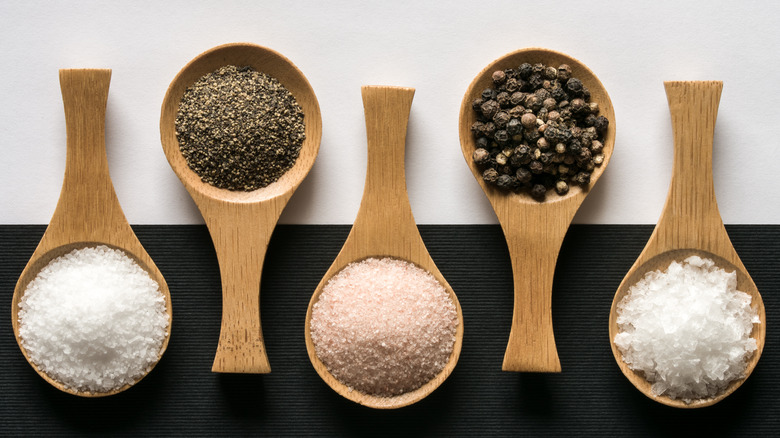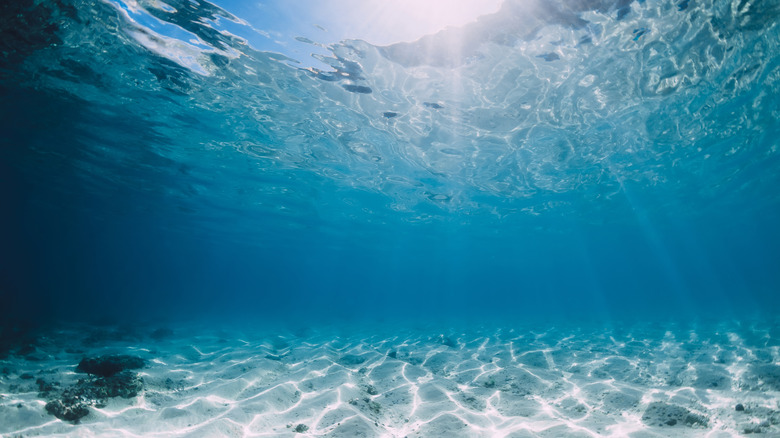Why Is The Ocean So Salty?
Earth is a unique planet in a lot of ways. It's magnetically charged, covered in active tectonic plates, and full of life. One of the most obvious traits that sets Earth apart is the abundance of water, a resource we've been searching for on other planets for decades. About 70% of the planet's surface is water, says the World Water Reserve, and most of it is contained in the huge oceans between continents.
Most of the world's oceans still haven't been fully explored. But there's one thing we do know for sure: The water there is absolutely full of salt. Most of the water on Earth is actually too salty for us to drink without getting sick or dehydrated. But the rivers and lakes that feed into the ocean aren't like that. Even the glaciers at Earth's poles are freshwater, according to World Water Reserve. So where does all of that salt come from, anyway?
Where the water comes from
You probably learned about the water cycle in science class when you were younger. It's how water circulates, creating the weather and keeping soil and groundwater sources hydrated. The water starts in a lake or ocean, for example, and evaporates into the air to become clouds. From there, it condenses into liquid and falls again by way of rain or other precipitation (via National Oceanic and Atmospheric Administration).
Once it hits the ground, that rainwater becomes runoff as it flows over the land to fill streams, rivers, and, yes, oceans. That process keeps the water levels up and prevents things like droughts. Additional sources of water include the glaciers at the Earth's poles, which contribute additional water as they melt. The water falling from the sky or melting off glaciers isn't salty, though — at least, not at first. That part of the process takes some additional steps.
How salt gets in the mix
Rain doesn't just fall directly into the oceans. Often, it first ends up on land and has to travel across rocks and minerals to get to a river or stream. From there, it travels until it reaches its final destination. And it's during that process that the water picks up salt (via National Oceanic and Atmospheric Administration – NOAA). As the rain runs over the rocks, it breaks them up and erodes them, according to NOAA, carrying bits of mineral into the waters where it ends up. That's where the salt comes from.
But the rivers and streams themselves won't stay salty. The rain refills them and adds some salt, but overall, most of the water moving through is still fresh. That dilutes the salt, according to NOAA. But the oceans aren't so lucky. They collect all of the water from the tributaries, and that means all the salt, too. The oceans likely weren't as salty in their early life, NOAA says, but as rainfall and runoff continued to carry salt to the water, the amount of minerals dissolved in the water grew until the oceans hit their limit — which is the level of salt they have today.
It's not just the runoff
The rain isn't entirely at fault for the salty oceans, though. There are other sources of rocks and minerals deep down on the ocean floor. According to the U.S. Geological Survey (USGS), salt comes up from the bottom of the ocean, too. Hydrothermal vents, where the Earth spews out hot geysers of ocean water, are part of the system. The vents themselves bring up water that seeped into the crust of the planet, according to USGS, dissolving more minerals and metals as they went. Once the water is hot enough, it's expelled back into the ocean water. And that water brings with it more dissolved salt.
There are even underwater volcanoes at the bottom of the ocean, according to USGS. Eruptions of molten magma bring more metals and minerals into the water and contribute to salinity levels. So while the rain up above is dragging bits of rock into the rivers and streams, the ocean does have a more direct source of salt hidden beneath it.
What is the salt made of?
Salt can refer to a number of chemical combinations, primarily based on atomic structure (via Mental Floss). Table salt is a specific combination of sodium and chlorine atoms. The most common minerals in the ocean are sodium and chlorine, but ocean salinity also includes smaller amounts of things like magnesium and sulfate, according to the National Oceanic and Atmospheric Administration.
Salt from the ocean is a little different from what you might be keeping on your kitchen table. There are some who prefer sea salt for flavoring their foods, and believe that since it tends to be less processed than other table salt, it's a healthier choice, especially with its traces of other minerals. Most researchers, however, have concluded that there's no real benefit to using sea salt instead of ordinary table salt (per Healthline).
Some parts of the ocean are certainly saltier than others, and the composition of the dissolved salts can vary based on location, too. Salt doesn't always stay in the water once it's been picked up, though. A lot of salt is consumed by marine life, according to NOAA, and plenty of it is deposited on the ocean floor. Some of the salt is harvested for human consumption, but you really shouldn't try and drink the water as it is.
An even trade
Water is essential to maintaining life on Earth. But, according to "Exploring Our Fluid Earth" (posted by the University of Hawaiʻi at Mānoa), salt is just as necessary. The fish and marine life in the ocean depend on it just as much as we rely on our table salt to flavor foods and meet our own nutritional needs — as Healthline explains, it's also possible to consume too little salt. Separating that salt from the ocean water can be an intensive process that harms the environment, but with so much ocean water around, it makes sense to look at ways to make use of the resources we have.
Seawater wasn't always salty, but it's just about hit an equilibrium. According to the National Oceanic and Atmospheric Administration, oceans are currently taking on about as much salt every year as they are depositing on the ocean floor. It's unlikely that we'll ever get back to a place where the oceans are safe to drink, at least for humans.

